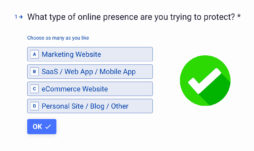Setting your website up for full data privacy and security compliance builds trust with your customers and keeps your business safe from liabilities and potential cybersecurity attacks.
Below, I compiled three website checklists to ensure your site complies with data privacy laws, uses security best practices, and implements appropriate policies to provide your customers with a positive experience.
I also spoke with a privacy expert to get their insights about data privacy and security best practices for website owners.
Website Privacy Checklist
Here’s an easy-to-follow checklist that explains every legal policy you should create and publish on your website to achieve full privacy compliance and offers tools and solutions to help simplify the process.
| Website Data Privacy Compliance Checklist | Sources and Solutions |
|
Required by the:
Termly Solution |
|
Required by the:
Termly Solution |
|
Required by the:
Termly Solution |
|
Required by the:
Termly Solution
|
|
Required by the:
Termly Solution |
|
Required by the:
Termly Solution |
|
Required by the:
Termly Solution
|
|
Technically, not required by any laws
Termly Solution |
|
May be required by consumer protection laws like:
Enforced by groups like Termly Solution
|
|
May be required by consumer protection laws like:
Enforced by groups like
Termly Solution |
Website Security Checklist
As our world becomes more digital, online businesses are exposed to more cybersecurity risks, like data breaches and illegal hacking.
I spoke with Jonny Pelter, Chief Information Security Officer and Founder of CyPro, who had this to say on the subject, “In a world where data breaches and cyberthreats are increasingly common, the way you, as business leaders, manage data can make or break your reputation and client relationships.”
You can think of personal data as the currency of trust. – Jonny Pelter, CISO & Founder, CyPro
Pelter adds, “Prospective customers are becoming more demanding and risk-aware. They expect transparency around how their data is used and protected.”
If the data you collect about your users’ gets compromised, you consumers and the law holds your business accountable.
Some all-too-common website security threats include:
Pelter offered the following tips for website owners, “Invest in cybersecurity measures like regular vulnerability assessments, encryption, and access controls to safeguard your data.”
“Don’t forget the human element—train your team regularly on privacy best practices and cyberthreats.”
Here’s a checklist of website cybersecurity best practices you should implement on your platform to prevent yourself from becoming a victim of one of these attacks and to keep the personal information you gather about users safe from breaches.
| Website Security Protocols and Procedures Checklist |
|
|
|
|
|
|
|
I’ve said it once before, but it’s worth repeating — if your business falls victim to a cyberattack and user personal data gets compromised, laws like the GDPR and the amended CCPA will hold you accountable, leaving you open to fines and other forms of enforcement.
Plan ahead and implement these business best practices now to keep yourself, your employees, and your customers safer online.
Additional Website Checklist Items
There are a few other policies you should post to your website, some of which help address consumer protection laws, while others are best practices that help protect your business and set proper customer expectations.
Check out the table below to see what else you should have on your website.
| Additional Policies Your Website May Need | Sources and Solutions |
|
Publish one to:
Termly Solution |
|
Publish one to:
Termly Solution |
|
Termly Solution |
|
Required by the: |
|
Required by the:
Termly Solution |
Why Data Privacy and Security Matters
It’s vital to prioritize data privacy and security online because it helps keep personal data safe from breaches and ensures legal compliance.
But even if you don’t meet the legal thresholds of privacy laws, data privacy statistics emphasize just how much customers care about and want to know what you do with their personal information, regardless of applicable legal requirements.
- 48% of users have stopped buying from a company over privacy concerns. (Tableau)
- 60% of users say they would spend more money with a brand they trust to handle their personal data responsibly. (Global Consumer State of Mind Report 2021)
If you don’t meet their standards, they’ll look elsewhere.
Choosing to ignore privacy best practices puts your business at risk of falling behind.
Summary
By setting up your website for proper data privacy and security compliance, you’re accomplishing two things.
You’re proving to consumers that your company is trustworthy and transparent, and you’re more adequately protecting your business from falling victim to cybercrimes and attacks.
Many website policies can easily be made in minutes using a managed solution, like Termly’s comprehensive suite of compliance solutions.
Plus, plenty of free resources exist.
With these checklists in your toolbox, you’re ready to create a secure, fortified environment online for your new and recurring customers.


